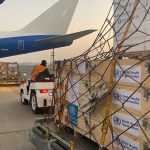Kale Logistics By R. Chandrakanth Leading the tech quantum leap on aireight & logistics
Another prime offering is the e-Marketplace, an online poal for booking door-to-door cargo transpoation services, offering competitive pricing and total transparency of the best shipment
options across all modes of transpo. The plaorm connects supply chain stakeholders; such as freight forwarders, Customs brokers, shipping lines, airlines, transpoers, consignees, warehouse operators, rail operators and regulatory authorities, enabling them to adopt modern logistics practices that will allow beer response to customer demand, increased efficiency and a more competitive industry landscape in air cargo space.
Digital transformation is heralding the next era in logistics and supply chain management and in the forefront is Kale Logistics Solutions, a global IT solutions paner for several Foune 500 companies worldwide. With in-depth domain knowledge and technical expeise, Kale Logistics is working on creating the world’s largest digital logistics cloud for the international supply chain by creating a global network of airpos and pos connected digitally through its Digital Corridors. Explaining in detail to Air Cargo Update the digital expanse of Kale Logistics Solutions is Amar
More, CEO and Co-Founder More holds the distinction of being the first and only Indian to receive the “CILT International Young Achiever Award – 2009 for his invaluable contributions to deliver tech solution to the logistics industry.
Digital transformation is a given thing now. Is the air cargo sector receptive to it, considering the high costs of going totally digital, more so, when the logistics industry is going through a margin squeeze?
Yes, Digital Transformation (DT) is the right thing to happen to the industry even though, a bit late, but not too late. The air cargo industry is receptive and understands the value DT will bring to their businesses. The mindset toward DT is not cost-centric but investment-centric, where the industry will reap benefits in the coming years and become sustainable.
The buzzwords in today’s board meetings are disruptive technologies – AI, ML, IoT, Blockchain, Cloud, Mobility, and AR are taking the center stage. The usage of these technologies has surpassed discussion and conceptualization to actual applications in business scenarios. For example, we have AI-based truck management systems at airports, Blockchain-based digital corridors, Machine Learning-enabled document to EDI conversion and many more.
Can you give some cost-benefit analysis for a freight forwarder such that the freight forwarding community understands the importance of digitization?
Every actor in the supply chain is touched by digitization in today’s world. In the past three years, the freight forwarding community has taken a quantum leap in tech adoption. The pandemic drove the need to go digital. Today, freight forwarders are facing two paths: digitize their processes and catch up with the industry, or become
obsolete and face very high costs. When it comes to addressing forwarders for digitization, we are dealing with a very
heterogeneous group with different levels of automation needs, customer expectations and scale of operations. Digitization benefits are both tangible and intangible for them. Tangible benefits including savings on charges like storage, demurrage, detention and abandoned cargo are very much possible. Document exchange can be executed within a few minutes as opposed to a few days previously. The other benefits, which cannot be immediately quantified are better customer service, fully automated sales, end-to-end tracking, document management, complete cargo visibility and prevention of revenue leakage with automated accounting and invoicing.
What segments of air cargo sector still continue with legacy systems that you think they can easily migrate to digital?
Any process which still needs paper or manual operations can be migrated to digital easily. In order to make digitization a success, every aspect and process should be touched by it. It should start with core operations and then move to other peripheral processes. We have generally observed that the SMEs in the air cargo supply chain are fragmented and are laggards in tech adoption. But with cargo community systems such as Kale’s Air Cargo Community System (ACS) and Logistics e-Marketplace, this gap is bridged. These unified platforms make technology, data, and best practices available and affordable to all supply chain stakeholders, including the SMEs. For example, in Mumbai International Airport and Bengaluru International Airport we have our CCS, which has 98% adoption, enabling the entire air cargo value chain to work as a synchronized operation.
One of the concerns of digital is the security of data, how does Kale address this?
With changing IT environments, cloudbased solutions offer agile and robust ondemand infrastructure with benefits such as stability, cost efficiency, and more. We must not forget concerns related to cyber security. More attempts have been made to steal passenger data (personal data, credit cards etc.) than cargo. Having said that, a shipment can often involve data or intellectual property transfer between up to ten separate parties across the globe, hence there is enough motivation for hackers to look at cargo data as well.
However, if there is an additional layer of a CCS, which typically has seven layers of security, and additional security layers provided by leading cloud providers like Microsoft and Amazon, the cyber security risks to the larger stakeholder systems go down significantl y. Icall it the democratization of cyber security. Cargo Community System (CCS) can democratize cyber security and help provide better security infrastructure to the smaller players and, by being a buffer layer with bolstered world-class security infrastructure, reduce the risks for the systems of larger players, too.
Digital being very dynamic, it calls for constant innovation. Can you name one game-changing innovation of Kale in the logistics industry? Also give the gamechanging attributes.
A cargo community system comes with some limitations as it has geographical boundaries, and to overcome the same and achieve larger synergies globally, one has to think beyond cargo community systems.
This brings us to the future of cargo community systems i.e., the digital trade corridor. The Digital Air Freight Corridor aims at creating a completely transparent supply chain through the exchange of real-time status of shipments between two airports and exchange of shipment data to eliminate duplicate processes. For example, shipment arrival information can be shared beforehand with the rightful stakeholders in the destination airport so that the Customs, handlers, and other stakeholders are well informed and prepared to handle the incoming freight on time. We have successfully established the first Digital Air Freight Corridor between India and Netherlands, powered by Blockchain.
Another prime offering is the e-Marketplace, an online portal for booking door-todoor cargo transportation services, offering competitive pricing and total transparency of the best shipment options across all modes of transport. The platform connects supply chain stakeholders; such as freight forwarders, Customs brokers, shipping lines, airlines, transporters, consignees, warehouse operators, rail operators and regulatory authorities, enabling them to adopt modern logistics practices that will allow better response to customer demand, increased efficiency and a more
competitive industry landscape in air cargo space.
The platform can connect with third-party systems, cargo community systems and systems of the airport authority and terminal operators to provide status updates. Along with digital, there is talk about sustainability. Please explain with specific examples how you factor in sustainability in customer operations. Sustainability is now a mega trend, as per the World Economic Outlook Jan 22. It’s no longer just important but a necessity. There is a perception by some airlines, airports and ground handlers that aviation’s reputation comes from the passenger business so there is no need to invest in sustainable cargo solutions as these are not visible. We must collectively change this situation.
We at the airfreight industry have a collective responsibility to our customers, employees and future generations to develop solutions creating a positive impact on people and the planet in ways that enhance business success, which in turn will lead to enhanced global prosperity.
Our CCS is developed as per United Nations recommendation 33, which sets the framework for sustainable trade facilitation through paperless operations. Kale’s Cargo Community System, used for airport and maritime community systems, enables electronic communications between multiple supply chain stakeholders. We want to add momentum to the global sustainability drive and be a key influencer for airports, ports, and supply chains globally to go paperless, improve digital connectivity, and reduce carbon emissions.
A study by Kale Info Solutions on the impact of digitization at Atlanta Airpo, Georgia, USA, has demonstrated CO2 and fuel savings, as well as reduced labor costs and close to 2,000 man-hours saved. The study showed that by using digital tools, the Atlanta Airpo Community, powered by Kale’s digital solutions, had saved nine tons of CO2 from being processed since the beginning of 2021: the equivalent of planting more than 1,500 trees. The study looked at 1,839 shipments, 389 trucks, and 680 tons of cargo going through Atlanta Airpo for the first seven months of 2021.
In total, more than 5,650 liters of fuel, USD 69,000 of labor costs, and 1,945 man-hours were saved by using Kale’s Slot Management tool to organize and facilitate the arrival and loading of trucks at the airport.
After two bad years due to Covid-19, how is the logistics industry looking and how can companies like Kale help them recover faster?
The last two years have been exceptional for air cargo as the pandemic induced just not uncertainty, staff shortages, and health risks but also made way for an eCommerce boom with congestion and high dwell times. These times have shown loud and clear that the logistics industry needs to stand unified to fight this battle.
As per WHO, the COVID-19 virus stays on paper for 72 hours, so contactless and paperless operations were the requirement of the industry. CCSpromoted this with Single Window Systems, powered by autonomous data exchange, online payments, eapprovals, digital signatures, barcoded gate-pass, digital customs, and e-delivery orders. The stakeholders enjoyed benefits, such as improved customer satisfaction with beer shipment visibility, improved data accuracy by 90%, security and reduced cost.
One of the most relevant offerings from our CCS is Truck Slot Management; here all truck arrivals and departures are managed as per slots to avoid gate congestion. Truckers experience much lower wait times at the terminal gates, & all documentation is predone before the truck reaches the terminal. The handler is equipped with advanced shipment information to plan the resources, equipment, and warehouse. The airlines receive an IATA-compliant e-AWB. So, all the actors are well synchronized, which ensures the cargo flow is seamless and quick, along with significant cost savings.
We hear some airports in Europe, including Heathrow, are stretched to deal with both passenger and cargo operations, how do you think technology/digital can help in addressing this resource crunch?
Business continuity was a big challenge during the pandemic times, with legacy systems and manual operations, the air cargo operations were poorly affected. Remote working was a novelty and the airports were not geared up to handle staff shortages. Because of the uncertainty of the times and the likely realities of the “new normal,” more and more airports are now charting the course for their journeys toward cloud computing and digital transformation.
Cloud-based applications enabled workfrom-home. Cargo operations continued uninterrupted with robust cloud-enabled platforms which enhanced productivity and collaboration. There was no need for heavy investments on infrastructure or highly trained staff to work on CCS.
Another point of contention was the COVID-19 virus staying on paper for 72 hours as per WHO and the paper-intensive air cargo industry had to move to paperless operations. This was an opportunity in adversity for the industry to adopt automation and digitization for information exchange, thereby making the entire supply chain efficient and agile.
Could you give details of your global operations – in how many countries you are present, the size of your client base, and the markets you are focusing on?
We have more than 5,000 customers globally in 30+ countries. We have been successfully engaging with 100+ air cargo stations across the world. We are focusing on North America as this is a big market for air cargo, and the geography is very receptive to digitization. We are engaging with Atlanta, Vancouver, Boston and many more airports are talking to us at this point in the region.
What are the challenges for a digital company such as yours when it comes to the logistics sector?
Unlike other industries, the logistics industry has varying degrees of IT maturity amongst its stakeholders. Large players have sophisticated IT solutions to manage their end-to-end operations, but the SMEs would still be on Excel-based data or worse maintain physical files. Though they are disparate in operations, what links them is the common data and cargo they handle at various times during the shipment journey. With different contours of IT systems, what suffers is the movement of cargo across the supply chain. There is data discrepancy, time-consuming operations, and a lack of trade visibility and transparency. Therefore, making the entire supply chain inefficient
and non-conforming.
Making the logistics fraternity aware of the benefits of digitization is the most critical part. In several regions, they are still reluctant for various reasons. In the Middle East especially, stakeholders believe that digitization will bring extra costs, and they need to set up a separate infrastructure for the same. However, not many understand that the tech solutions do not require a separate infrastructure cost.
What is Kale’s roadmap, say for the next 5 years?
We strive hard not only to stay relevant but try to create a digital future for the industry. We are working on expanding the reach and depth of our community platform by providing value-added features to the community like complete enterprise applications for Customs brokering as well as freight forwarding rolled out through our CCS platforms.
We are also working on creating the world’s largest digital logistics cloud for the international supply chain by creating a global network of airports and ports connected digitally through our Digital Corridors. We believe that the future is multimodal, so we are working on creating Sea-Air corridors to facilitate intermodal cargo movement. Our large communities will get integrated with our Logistics eMarketplaces, which are under development.
We continue to expand our operations across the globe. We are also working on implementing the deep tech use cases of IoT, Blockchain, AI, and ML in our community platforms.















